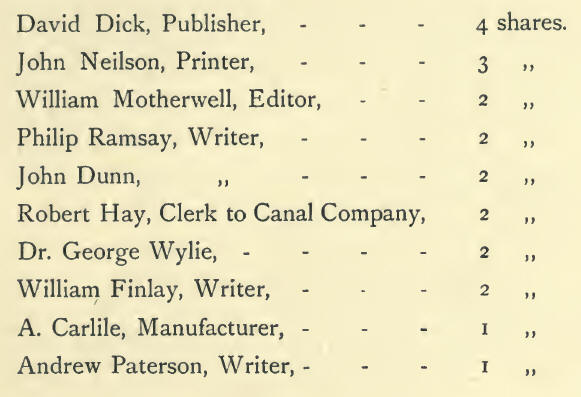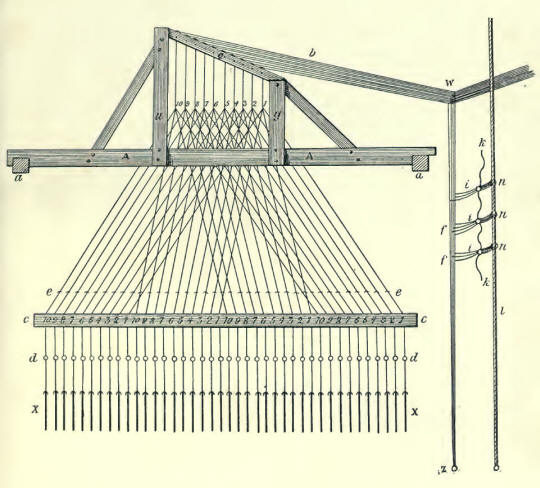|
THE literary culture which resulted from the
conditions of society in the palmy days of the hand-loom weaving, is shown
in the number of magazines and periodicals that were started in Paisley.
They exhibited considerable merit, but all were very short lived.
The Weavers' Magazine was a monthly publication issued
in i8r8, and twelve numbers only were brought out. It was the only one which
had a definite connection with the weaving trade. It gave a monthly review
of the various classes of goods then made in Paisley. Many of these were of
harness work, with a considerable amount of silk, but the true "Paisley
Shawl" had not appeared at that date. There are a few original articles in
the magazine, but the greater part consists of instructive and interesting
selections, together with a little original poetry of no special note. The
names of the authors of original matter are not given.
A more ambitious effort was made in 1828, when the
Paisley Magazine appeared. It was a monthly publication, and continued for
one year. This magazine had no special reference to weavers, but is an
indication of the culture of the period. It was got up by a joint stock
company, of which the shareholders were :-

A guinea was
advanced for each share. The editor received two guineas for each number
issued. - William Motherwell, the poet, who
was Sheriff-Clerk Depute at that time, was the editor, and contributed a
large part of the contents. Other contributors were Mr. John Dunn, Writer,
whose papers show a wide range of reading, and Mr. Robert Hay, Engraver. Mr.
Hay had been a sailor in his youth, and besides articles on general
subjects, contributed under the nom de plume, sometimes of Sam Spritsail,
and sometimes of Bill Bobstay, a series of papers which are in a large
measure auto-biographical, and much in the style of Smollet's Roderick
Random. Although none of the articles are
signed, it is known that the following gentlemen, among others, were
contributors :—Philip Ramsay, Writer; William Finlay, Writer; A. Carlile,
Thomas Crichton, William Kennedy, J. Fullarton, A. Johnston, and R. Peacock.
The descendants of some of these contributors are still among our most
respected townsmen. The magazine contains numerous poetical pieces, the
greater number being by the editor. The general merit is of a very high
order, although the writing would now be considered somewhat heavy. There is
no selected matter; all the articles are original.
In 1841 and 1842 appeared The Renfrewshire Annual.
These two volumes were edited by a lady—Mrs. Maxwell of Brediland—and are
only connected with the weaving trade, in so far that all the illustrations
in the volume for 1842, except one, are the work of Sir J. Noel Paton, who
was -a pattern designer in Paisley at that time. They are also the first
indication of that graceful drawing of elves and fairies, which the artist
carried to great excellence in his later works. Sir Noel, who was plain Neil
Paton in those days, was designer to Messrs. Brown, Sharps & Company. (Plate
15). Another designer at this, or a rather
later date, was Alexander Smith, the poet, author of A Life Drama, and other
works. Smith's father was a designer, and the son was brought up to the same
occupation. But he had no special bent for art, and when the shawl trade
decayed, he betook himself to the more congenial paths of literature and
poetry. His poetical works are of a style of superabundant metaphor much
admired at that time. His prose is excellent; his essays particularly so.
The scenes in his novel of AlJred Hagšart's Household, are laid in Paisley
and neighbourhood. (Plate 15.)

Many writers have endeavoured to paint the manners and
peculiarities of the Paisley weavers, but none have succeeded so well as the
late Mr. David Gilmour, author of The Pen Folk and other works. (Plate 15).
Although, as he says himself, he never was a weaver, he had worked as a
draw-boy and, excepting the mechanical operation of throwing the shuttle, he
had learned to understand the loom, as well as most weavers. This early
training enabled him to occupy the position of general manager for Mr.
Robert Kerr, one of the most prominent of the Paisley Shawl manufacturers,
and afterwards to become a manufacturer on his own account. In all these
capacities, with so large a part of the weaving population of Paisley
passing through his hands, he had wide opportunities of studying and
appreciating the weavers' intellectual power and independence of life.
Gifted with a natural shrewdness, and a fund of quiet humour, his warm
sympathy with the weavers in their difficulties, and his keen sense of
justice in dealing with them, brought him very near to them, and made him to
be universally beloved. He was a frequent referee in their trade disputes,
and that their respect for him was fully reciprocated on his part, he has
shown in all his writings. Those who had the pleasure of his acquaintance
were always amused by his wealth of anecdote and pawky humour. It is most
fortunate that when he saw this type of people and of life passing away for
ever, he felt the impulse to record it. He was particularly qualified to
appreciate the religious side of the character of the weavers, and this
forms the leading note in all his writings.
It
was somewhat late in life when, suggested by the death of an old Paisley
weaver, Mr. Gilmour sat down to write his charming book, The Pen Folk,
published in 1871. It was a sketch of the religious side of the Paisley
weavers: the story of a little group of earnest Christian men and women, who
met every Sunday in a room in the "pen" or passage from High Street to
Oakshaw Street. The book gave a delightful picture of the simple manners of
the time, and immediately attracted attention. In 1876 he published Paisley
Weavers oJ Other Days, where the same subject is continued, but more from
the secular side. Gordon's Loan Sixty Odd Years Ago, written in 1881, is
also a delightful fragment, dealing mostly with the political and
socialistic leanings of the weavers, and their longings for the "equal
divide." |

